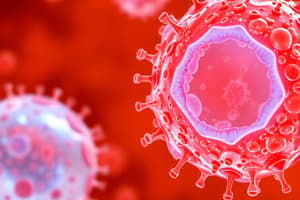Podcast
Questions and Answers
Why is the direction of nucleic acid polymerization exclusively 5' to 3'?
Why is the direction of nucleic acid polymerization exclusively 5' to 3'?
- Energy from the incoming base's 5' triphosphate fuels phosphodiester bond formation. (correct)
- The 3' end contains phosphate groups which provide energy for the reaction.
- Polymerization in the 3' to 5' direction allows for more efficient proofreading.
- The 5' end contains hydroxyl groups necessary for the binding of new nucleotides.
What is the primary consequence if the human mutation rate increased tenfold?
What is the primary consequence if the human mutation rate increased tenfold?
- A significant reduction in the complexity of viable organisms. (correct)
- A greater variety of organisms would evolve.
- A decrease in the rate of germ cell mutations passed to offspring.
- An increase in the development of somatic cell cancers.
Which of the following best describes the role of a primer sequence in DNA polymerization?
Which of the following best describes the role of a primer sequence in DNA polymerization?
- It prevents errors by blocking the insertion of incorrect nucleotides.
- It offers a 3'-OH group, which acts as a starting point for nucleotide addition. (correct)
- It provides the necessary energy for phosphodiester bond formation.
- It initiates DNA replication by unwinding the double helix.
What is the primary mechanism by which DNA polymerase ensures accurate base pairing during replication?
What is the primary mechanism by which DNA polymerase ensures accurate base pairing during replication?
What cellular event is most likely to result from mutations in germ cells?
What cellular event is most likely to result from mutations in germ cells?
During DNA replication, the 3' to 5' exonuclease activity of DNA polymerase is crucial for:
During DNA replication, the 3' to 5' exonuclease activity of DNA polymerase is crucial for:
Given the average human mutation rate, approximately how many new gene mutations will a zygote accumulate relative to its parents?
Given the average human mutation rate, approximately how many new gene mutations will a zygote accumulate relative to its parents?
Which characteristic of DNA polymerase contributes most significantly to the high speed of DNA replication?
Which characteristic of DNA polymerase contributes most significantly to the high speed of DNA replication?
Flashcards
Somatic Cells
Somatic Cells
Adult tissue cells that undergo mitosis; transmit germ cell information.
Germ Cells
Germ Cells
Cell division that produces sperm/egg cells.
Somatic Cell Mutations
Somatic Cell Mutations
Localized cell death or dysfunction, which can lead to cancer.
Germ Cell Mutations
Germ Cell Mutations
Signup and view all the flashcards
Zygote Mutation Accumulation
Zygote Mutation Accumulation
Signup and view all the flashcards
Semiconservative DNA Replication
Semiconservative DNA Replication
Signup and view all the flashcards
DNA Ends (5' and 3')
DNA Ends (5' and 3')
Signup and view all the flashcards
DNA Polymerase Function
DNA Polymerase Function
Signup and view all the flashcards
Study Notes
- Somatic cells are adult tissue cells that undergo mitosis and are dedicated to transmitting germ cells.
- Germ cells undergo meiotic cell division to produce sperm/egg cells.
- Mutations in somatic cells can lead to localized cell death/dysfunction and potentially cancer development.
- Mutations in germ cells can result in offspring failure or long-term genetic disorders due to the numerous cell divisions post-conception.
- A new zygote accumulates an average of 70 novel gene mutations relative to its parents.
- The human mutation rate is approximately 1 nucleotide change per 10^8 bases per human generation, or 1 mutation per 10^10 bases per cell division.
- High fidelity in DNA replication is crucial for life, with the current mutation rate limiting the number of essential proteins to about 30,000 per genome.
- A tenfold reduction in replication fidelity would potentially limit organisms to 3,000 proteins, preventing complex organisms from evolving.
- The semiconservative model of DNA replication involves the double helix splitting into two parent strands, resulting in two daughter double helices each containing one template strand and one newly synthesized strand.
- The Meselson-Stahl experiment used heavy nitrogen to demonstrate semiconservative replication, separating parent and daughter strands by weight through centrifugation.
- Nucleic acid polymerization occurs in the 5' to 3' direction.
- The 5' end of a nucleotide contains phosphate groups, while the 3' end contains a hydroxyl group.
- The high spontaneous hydrolysis rate of triphosphate favors the 5' to 3' polymerization direction, allowing for error correction by replacing incorrect bases with the correct ones using available energy.
DNA Polymerase
- DNA polymerase enzymes catalyze the addition of nucleotides during DNA replication.
- These polymerase enzymes operate in the 5' to 3' orientation, using the energy from the incoming base's 5' triphosphate to fuel phosphodiester bond formation.
- DNA polymerase requires double-stranded DNA to initiate polymerization, using a primer sequence that provides a 3'-OH launch point.
- DNA polymerase is accurate, with proofreading functions via a 3' to 5' exonuclease activity, resulting in approximately 1 in 10^3 errors per nucleotide added.
- A single DNA polymerase enzyme has different regions dedicated to polymerization and editing.
- DNA polymerase is fast, operating at a rate of approximately 1000 bases per second.
Accuracy of Replication
- Protein structure and thermodynamics contribute to accurate base pairing during replication.
- The formation of correct Watson-Crick base pairs is thermodynamically favorable due to specific hydrogen bonding patterns.
- An incorrect base is likely to exit and diffuse away before being incorporated by the polymerase enzyme.
- Formation of a correct Watson-Crick base pair induces a structural change in the surrounding DNA polymerase, causing it to clamp down and position the 5'-PO4 and 3'-OH groups to catalyze phosphodiester bond formation.
- Release of energy during bond formation reopens the enzyme and translocates it to the next unpaired base.
Studying That Suits You
Use AI to generate personalized quizzes and flashcards to suit your learning preferences.




